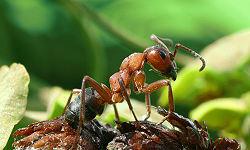Formica rufa
| Formica rufa | |
|---|---|

| |
| Formica rufa worker | |
| Scientific classification | |
| Kingdom: | |
| Phylum: | |
| Class: | |
| Order: | |
| Family: | |
| Subfamily: | |
| Genus: | |
| Species: | F. rufa
|
| Binomial name | |
| Formica rufa | |
Formica rufa, also known as the southern wood ant or horse ant, is a boreal member of the Formica rufa group of ants, commonly found throughout much of Europe[2] in both coniferous and broad-leaf broken woodland and parkland. Workers can measure 8–10 mm in length. They have large mandibles and like many other ant species they are able to dispense formic acid from their abdomens as a defence. Formic acid was first extracted in 1671 by the English naturalist John Ray by distilling a large number of crushed ants of this species.[3]

A common diet for a wood ant colony is invertebrates found around the nest, particularly aphids harvested from the surrounding trees, although they are voracious scavengers. Nests of these ants are large, conspicuous, dome-shaped edifices, usually situated in woodland clearings, where the sun's rays cannot reach them. F. rufa is commonly used in forestry and is often introduced into an area as a form of pest management.

F. rufa is highly polygynous and often re-adopts post-nuptial queens from its own mother colony, leading to old, multi gallery nests which may contain well over a hundred egg-producing females. These colonies can often measure several metres in height and diameter. Formica rufa is aggressively territorial, and will often attack and remove other ant species from the area. Nuptial flights take place during the springtime and are often marked by savage battles between neighbouring colonies as territorial boundaries are re-established.[citation needed]

Workers show considerable polymorphism and it has been noted that larger individuals forage further away from the nest.[4]
The species can also establish nests using the mechanism of temporary social parasitism, the hosts being species of the Formica fusca group, notably F. fusca and F. lemani, although incipient F. rufa colonies have also been recorded from nests of F. glebaria, F. cunnicularia and similar species including the Lasius genus.
Bee paralysis virus
In 2008, the Chronic bee paralysis virus (CBPV) was reported for the first time in this species and another species of ant, Camponotus vagus. CPPV affects bees, ants, and mites.[5]
References
- ^ Template:IUCN2006
- ^ "Formica rufa".
- ^ Charles Earle Raven (1986). John Ray, naturalist : his life and works. Cambridge University Press. ISBN 0521310830.
- ^ Wright PJ, Bonser R & Chukwu UO (2000). "The size-distance relationship in the wood ant Formica rufa". Ecological Entomology. 25: 226–233. doi:10.1046/j.1365-2311.2000.00253.x.
- ^ Detection of Chronic bee paralysis virus (CBPV) genome and its replicative RNA form in various hosts and possible ways of spread.
External links
- [1] - Video of formica rufa shooting formic acid.
- Southern wood ant , southern wood ant pictures Macro photography of southern wood ant

